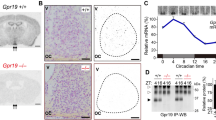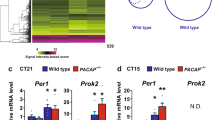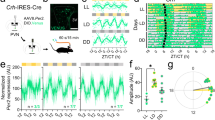Abstract
The type A GABA receptors are thought to mediate synchronization of clock cell activity within the suprachiasmatic nuclei (SCN). Here we report that casein kinases I ε and δ (CKIε and CKIδ), the crucial clock regulators, form a complex with GABAA receptors and inhibit the receptors' function within the SCN according to a circadian rhythm. These results indicate that circadian variation of the kinase-receptor association may mediate regulation of GABAA receptor function by CKIε-CKIδ in the SCN.
This is a preview of subscription content, access via your institution
Access options
Subscribe to this journal
Receive 12 print issues and online access
$209.00 per year
only $17.42 per issue
Buy this article
- Purchase on Springer Link
- Instant access to full article PDF
Prices may be subject to local taxes which are calculated during checkout


Similar content being viewed by others
References
Welsh, D.K., Logothetis, D.E., Meister, M. & Reppert, S.M. Neuron 14, 697–706 (1995).
Reppert, S.M. & Weaver, D.R. Nature 418, 935–941 (2002).
Moore, R.Y. & Speh, J.C. Neurosci. Lett. 150, 112–116 (1993).
Liu, C. & Reppert, S.M. Neuron 25, 123–128 (2000).
Lowrey, P.L. et al. Science 288, 483–492 (2000).
Lowrey, P.L. & Takahashi, J.S. Annu. Rev. Genet. 34, 533–562 (2000).
Toh, K.L. et al. Science 291, 1040–1043 (2001).
Eide, E.J., Vielhaber, E.L., Hinz, W.A. & Virshup, D.M. J. Biol. Chem. 277, 17248–17254 (2002).
Eide, E.J. & Virshup, D.M. Chronobiol. Int. 18, 389–398 (2001).
Swope, S.L., Moss, S.J., Raymond, L.A. & Huganir, R.L. Adv. Second Messenger Phosphoprotein Res. 33, 49–78 (1999).
Brandon, N., Jovanovic, J. & Moss, S. Pharmacol. Ther. 94, 113–122 (2002).
Liu, F. et al. Nature 403, 274–280 (2000).
Wan, Q. et al. J. Neurosci. 17, 5062–5069 (1997).
Wan, Q. et al. Nat. Neurosci. 2, 401–403 (1999).
Macdonald, R.L. & Olsen, R.W. Annu. Rev. Neurosci. 17, 569–602 (1994).
Acknowledgements
This work was supported by a grant to Q.W. from Canadian Institutes of Health Research (CIHR). Q.W. is a CIHR New Investigator.
Author information
Authors and Affiliations
Corresponding author
Ethics declarations
Competing interests
The authors declare no competing financial interests.
Supplementary information
Supplementary Fig. 1
Rhythmic variation of the physical association between GABAARs and CKIε/δ in the SCN. (a,b) Immunoprecipitation performed with an anti-GABAAR β2/3 antibody led to the coprecipitation of CKIε (a) or CKIδ (b) at the early light phase (ZT2-4) of LD cycle, but at ZT14-16 of the early dark phase, remarkably fewer CKIε (a) or CKIδ (b) were coprecipitated by anti-GABAAR β2/3 from the SCN tissues. Graphs on the right panels summarize the rhythmic variation of the kinase-receptor complexes (Student's t-test, *P < 0.05). Data shown in each graph are normalized to the average measured in control and are means ± s.d. of four determinations. (JPG 39 kb)
Supplementary Fig. 2
pecificity of GABAAR-CKIε interactions in the SCN. (a) The anti-CKIε antibody coprecipitates the same amount of GABAAR β2/3 subunits in rat hippocampal CA1 tissues at both ZT2-4 and ZT14-16 in LD, suggesting that the rhythmic variation of GABAAR-CKIε association is specific to the SCN. Data shown in the graph are normalized to the average measured in control and are means ± s.d. of four determinations (Student's t-test, P > 0.05). (b) The anti-CKIε antibody coprecipitated GABAAR β2/3, but not NMDA receptor NR1 subunits in the SCN tissues at ZT2-4 in LD cycle, indicating a specific regulation of GABAARs by CKIε in the SCN. (JPG 31 kb)
Rights and permissions
About this article
Cite this article
Ning, K., Li, L., Liao, M. et al. Circadian regulation of GABAA receptor function by CKIε-CKIδ in the rat suprachiasmatic nuclei. Nat Neurosci 7, 489–490 (2004). https://doi.org/10.1038/nn1236
Received:
Accepted:
Published:
Issue Date:
DOI: https://doi.org/10.1038/nn1236



